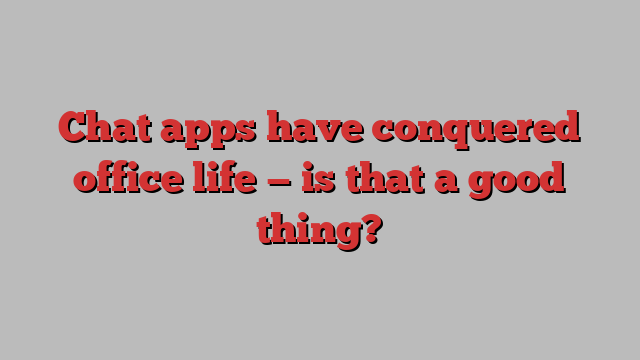
Unlock the Editor’s Digest for free
Roula Khalaf, Editor of the FT, selects her favourite stories in this weekly newsletter.
The way early Slack adopters talked about workplace messaging in the 2010s sounds unhinged today. It was a “friend” in the office, the “glue” keeping teams together and the reason work was fun. Of course, we now know that nonstop messages make it harder to log off. But at least we get to send emojis to our bosses.
In compensation for chaining us to our jobs, workplace messaging has helped to upend office norms. The idea that work requires a separate, stiffer identity is falling out of favour.
Some combination of new generations in the workforce and a pandemic-charged rise in remote working has resulted in a more casual tone. Suits, ties and other markers of formality are less popular. “Yours sincerely” email signoffs are being traded for a simple “Thanks”. Internal chats rarely have signoffs at all — beyond a thumbs up. Slack and Microsoft Teams even allow workers to play video games.
California got there first. When I arrived here in 2018, I had a wardrobe of uncomfortable work clothes and an assumption that email and phone calls were the way to contact colleagues. On the first day, I was introduced to the Financial Times San Francisco bureau’s rapid-fire Slack conversations. Within the first week I realised that every meeting I attended would be an assembly of jumpers and trainers and changed my wardrobe accordingly.
The tech sector has proved that casual does not equal unprofessional or unproductive. But this idea is still filtering through to some of the more conservative parts of society. So is the question of exactly what sort of work should be taking place via chat.
I thought of this while sitting in the courtroom for the trial between Epic Games and Google late last year. While the lawsuit focused on Google’s app store, the judge seemed astonished that so much of Google’s work was taking place on chat.
He criticised the company for allowing such communication to be treated differently from email. Auto-delete settings on messages contribute to their ephemeral, conversational tone. However, the judge described this as the suppression of evidence.
I have been using chat interchangeably with email without thinking about this. Its similarity to texting means that it is easy to blend personal and professional conversations too. The number of different group chats and individual messages creates a constant background noise that it is possible to dip in and out of in a way that feels addictive, if not always productive.
To see how this happened, you have to travel back more than a decade to San Francisco in 2013. Messaging tools for organisations — or enterprise platforms — were not new. Google had been trying to push such a service for almost as long as it had had email, launching Google Talk in 2005, one year after Gmail. There were start-ups, too. But Slack was the one that caught fire.
The reason Slack has video game-esque colours is because it was born out of a start-up that was building a multiplayer online game. When this failed to take off, founder Stewart Butterfield pivoted to develop the team’s internal chat platform. It proved popular with other start-ups, who praised the design. By 2015, tech publication Wired wrote a story titled: “Shut down your office. You all work at Slack now.”
Workplace messaging companies such as Slack say the communication method reduces the demand for meetings. Emojis offer shorthand reactions that cut down the number of messages. Such instant messaging has even been credited with lowering noise in open-plan offices by moving incidental chatter online.
The downside is what happens when employees let their guard down too far and forget they are using a work tool that is not always private. Bari Weiss pointed to Slack when she resigned from the New York Times, saying fellow workers were criticising her on the platform and posting an axe emoji next to her name in company-wide channels.
In the past year or so, Slack has lost some of its lustre. This is partly the aftermath of a staggering $28bn takeover by Salesforce in 2021. Instead of being a rogue upstart, it is now part of software giant Salesforce. Sales growth has fallen. In the last quarter, it was 16 per cent, down from 33 per cent the previous year. The co-founders have left. Along with every other tech company, it is pinning its hopes on generative artificial intelligence.
But Slack’s dip in popularity is not a reflection of workplace-messaging aversion. It is the result of rivals such as Google using their resources to take its share. The culture of nonstop, informal workplace chatter that it helped to create is going nowhere.

